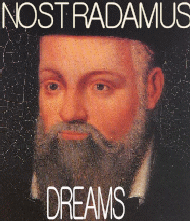 |
The rationale underpinning the anagrams found in Nostradamus' Prophecies.© Allan Webber 2016 |
 |
Since the start of 2016 I have been preparing my material for a new publication that will be more reader-friendly than my research papers can ever be. In preparing this current work I have aimed to reproduce the fundamentals of my earlier research papers using Nostradamus' own words from his 1555 Preface to Cesar, the 1558 Epistle to Henry and the two tranches of prophecies published in those same years.
I know I can achieve this task however if I don't include the most essential parts of my research that which would result would be like an X-ray; valuable in showing the bones but lacking the flesh, colour and life of the actual objects being examined.
As I prepared the first chapters I felt the scantiness this restriction on using anagrams produced. This was especially so when I was presenting the section on the Paracletes where I had need to show anagrams in different languages that were synonyms for identical themes. This I resolved easily enough because these were anagrams from the past and of a type that Nostradamus might well have chosen as ciphers to identify themes. The technique of ciphers was commonly used in the sixteenth century as were anagrammatic techniques based on the Hebraic Kabbalah. And Nostradamus was adept in many classical languages and had exposure to people who spoke the tongues of nearby countries.
But Nostradamus' work is about the future and meaningful discussion of futuristic themes requires a language not known in his day and his text reflects that. However there are many wordings that hint at modernity.
And there the difficulty for my analyses begins because I do find a host of modern English words, names for modern places and modern technological terms amongst the anagrams. I would have preferred to ignore these but they display attributes that make this difficult. For instance they cluster in groups around topics which are known to be Nostradamus' themes and there are very few from unrelated themes.
The following is an extract from my papers in 2004 where the clustering effect was analyzed on a small sample of the anagrams found. The table below shows the topics where the anagrams in Nostradamus' text have the greatest deviation from those in a group of other sources.
Long word Anagram Comparison by Topic- Table 2
| Prophecy | Machines | Disaster | Classify | Maths | Commerce | History | Geology | |
| Nostradamus | 10 | 9 | 8 | 9 | 7 | 7 | 6 | 6 |
| Other Sources | 2 | 3 | 1 | 0 | 2 | 0 | 0 | 0 |
| Total | 12 | 12 | 9 | 9 | 9 | 7 | 6 | 6 |
| RATIO Nost / Others | 5.0 | 3.0 | 8.0 | >10 | 3.5 | >10 | >10 | >10 |
In the remainder of this chapter I want to give some understanding of what my analyses have established over the last twelve years.
 It
was in 2004 that I constructed a research into anagrams within texts of
different languages to understand how complex word-structures come about
by chance in that same language and in other different languages.
It
was in 2004 that I constructed a research into anagrams within texts of
different languages to understand how complex word-structures come about
by chance in that same language and in other different languages.
Amongst the most significant results was that the formation of anagrams is not uncommon in any written document but even allowing for this Nostradamus' Prophecies held more than any of the other tested texts. Further testing showed that amongst the longer anagrams those found within the Prophecies had a high correlation with the major themes nominated by Nostradamus in his Preface and Epistle. Not only was this true but they showed higher relevance to each other than did those found in the other texts.
When I first obtained these results for English and French anagrams I could find no great difference between the two forms. There was however a significant difference when either text was randomly scrambled. Under this process each reduced back to a base that truly represented random occurrence and any clustering effects disappeared. From this I deduced some of the detected differences were a part of their structure and not chance alone.
Languages often use loan words or take their roots from a common source which explains why I found it hard to choose a technique on the basis of language alone. To overcome the reality of randomly generated words I then introduced new disciplines into my analysis. It is not possible to be absolutely sure that any anagram found is there by deliberate intent but the chance of falsehood is reduced when the anagrams reflect the message in the text particularly where they form synonyms or are appropriately descriptive. It also reduces the likelihood of chance if the anagrams form comprehensive phrases. This is also true if they are words taken from the same categories as words found in other verses.
From 2004 on I chose to use English as my exploration vehicle while keeping my mind alert to the possibility that other languages might be involved. I knew from my earlier research on clustering that whichever language (if any) had been used as the original code a wrong choice of main-test-language would still mirror the same code. So my choice to use English was then rationalised by other factors.
There are good reasons why a capable prophet would choose to use English when telling the story of future times since many words we use today tend to have not existed five centuries ago and every language has been supplemented by universal forms. And the 'lingua franca' of modernity tends to be English which means all languages now embrace many words found in English dictionaries.
Now the chart included at the start of this chapter reveals that for anagrams greater than 13 letters long two-thirds of these in Nostradamus' text are less likely to be the product of chance while for those with less letters this ratio drops quite rapidly. At the level above eight to ten letters the chance of them being valid falls to one in ten. It is obvious that anagrams forming the longest groupings provide the most validity but their occurrence by chance cannot be ruled out.
Therefore when reading my analysis and the work on anagrams be aware that it cannot deliver absolute proof of meaning and it is only through its internally interwoven patterns that story lines can be defined. The real source for understanding Nostradamus prophecies remains the prose and poetry writings and it is only when the anagrams deliver enlightenment to Nostradamus' writings that I refer to them.
With all the above caveats and reasons in place I can state what the years of analysis since 2004 have added to my understanding. The main aspect arises from the success I have had using English anagrams as the main focus with French, Greek, Latin and Provencal as location-relevant augmentations. It is with this approach that I have come to understand the many enigmas in Nostradamus' prose writings and to appreciate the motivations and rationale behind each aspect of the Prophecies. In addition I have often tried to remove the English anagrams and use only French variants but the process of creating consistent story lines then tends to inevitably fail. So the justification of using English lies only in the end result, it surprisingly works where it is expected to fail.
There are countless examples which I can use to illustrate the foregoing claims and these include those shown in a chapter where I showed how the Paraclete or Holy Ghost provided a cipher for the theme of a religious clone. And terms such as pole star and Polaris which aren't directly related to religion establish their relevance from the other locations where they occur. As date clues the pole star becomes the consistent unifier of tales about the end of the 21st century and the start of the 22nd. By this means they define the one hundred year interval from 2000 to 2100 CE when Nostradamus' great mutations will occur.
The concept of different languages being used for anagrams to resolve the text's story lines is well illustrated in verse C1 Q100 where there are critical anagrams in lines which say For a long time a gray bird will be seen in the skies...Holding a flowering branch in its beak. This verse's anagrams offer a range of complex words such as pneumatologies (oiſeau Long temp), auguries (ra veu gris), auspice (ps au cie), Osiris (ris oiſ) and Asclepius (ps au ciel ſ) that form a unifying frame for gods, birds and the great floods of Egypt, Greece and Rome. Despite the disparity of their linguistic sources they offer a theme in keeping with the text's hints of the story of Noah whereby he read the meaning of a bird's flight.
C1 Q100
For a long time a gray bird will be seen in the skies
near Dole and the lands of Tuscany.
Holding a flowering branch in its beak,
but he dies too soon and the war ends.Long temps au ciel ſera veu gris oiſeau.
Aupres de Dole et de Touscane terre
Tenant au bec vn verdoyan trameau
Mourra tost grand et finera la guerre.
The above are backwards looking anagrams that make them more acceptable but there are countless examples I can offer that show futuristic usage in the Prophecies. The haunting way in which English anagrams mirror the words of a line's text is well illustrated by the two examples given below.
C7 Q19 L3
This deed will be debated for a long time,
Son faict Sera vn long temps de batu
factionS governmental budapeSts.
C3 Q59 L2
The greater part of his blood he will put to death
La plus grand part de ſon ſang mettra a mort
_____________partdeſonſ angmettraamort
_____________tranSpoSed tetragrammaton.
La plus grand part de ſon ſang mettra a mort
_aplus______partdeſ_ onſang_mettra_amortL
_paul's_____mortaL matter agennoS departS
Although both lines are presented here in isolation they are highly interconnected with other lines in their same verse and reflect themes that recur in the Prophecies. The depth of relationships are surely highly unexpected and difficult to accept as chance occurrences when they are not isolated but a part of a rich scheme throughout Nostradamus' Prophecies. It is this richness that generates my confidence in my hypothesis about English anagrams since they have proved a powerful tool for understanding the Prophecies throughout twenty years of usage.
And in addition to the above there is a huge lexicon of words that reflect similarly unusual connections between verse text and complex anagrams. These include denuclearisation, asteroid, meteorite, dinosaurs, pterosaurus, genomist, eugenist, Malthusian, financiers, corporations and thousands of others.
So it isn't just the anagrams that led me to the story lines but their location in the text together with their unity with complex anagrams around them. And it is because they are so deeply integrated with the themes in each verse that I have chosen to present the most powerful of them along with the story lines in the text.
|